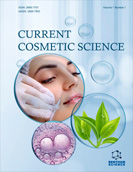Abstract
Ursolic acid (UA) has been utilized to improve memory-related cognitive processes and intellectual functions. This study aims to examine the ethnobotanical uses, phytochemical composition, toxicity, and central nervous system activities of UA. It promotes learning and memory and has biological effects against Alzheimer's disease, Parkinson's disease, and cognitive impairment, according to pharmacological investigations. UA did not cause any death, abnormal body weight, or pathological diseases at any of the test doses. Furthermore, no behavioral, neurotoxin, coagulation, haematological, or clinical chemistry changes were seen as a result of UA treatment. UA is also used as a cosmeceutical product to improve skin functions. This article examines all knowledge that has become available at this time for revealing the chemistry of the current has been extensively investigated based on the data, resulting in UA derivatives with improved potency, bioavailability, and stability being used to treat a number of non-communicable diseases. The pharmacological activity of UA has been exploited to improve learning and memory and treat depression, emotional stress, fatigue, anxiety, insomnia, Alzheimer’s disease, Parkinson’s disease, epilepsy, and schizophrenia. The effects of UA on the central nervous system detailed in this review. The majority of UA studies have been preclinical evaluations of cellular mechanisms in the central nervous system, and more translational clinical research is needed to assess the drug's safety and efficacy, as well as its favorable, biodistribution, which could be targeted using different pathways and administration routes. Several in vitro and in vivo studies have investigated the pharmacological properties of UA reporting neuroprotective effects and improvements in cognitive function. These effects are attributed to its antioxidant, antiapoptotic, and anti-inflammatory actions.
[http://dx.doi.org/10.2174/15680266113136660197] [PMID: 24083789]
[http://dx.doi.org/10.1007/s10295-015-1723-5] [PMID: 26739136]
[http://dx.doi.org/10.1016/j.toxrep.2020.04.005] [PMID: 32435599]
[http://dx.doi.org/10.1016/j.bmc.2019.115150] [PMID: 31635893]
[http://dx.doi.org/10.3390/molecules23092300] [PMID: 30205592]
[http://dx.doi.org/10.1016/j.ejmech.2017.07.013] [PMID: 28754470]
[http://dx.doi.org/10.1016/j.lfs.2013.11.019] [PMID: 24333132]
[http://dx.doi.org/10.3390/molecules14062016] [PMID: 19513002]
[http://dx.doi.org/10.3390/molecules201119721] [PMID: 26610440]
[http://dx.doi.org/10.1002/ardp.201800222] [PMID: 30663087]
[http://dx.doi.org/10.1155/2017/2984562] [PMID: 28781908]
[http://dx.doi.org/10.1016/j.pbb.2012.08.016] [PMID: 22940588]
[http://dx.doi.org/10.1016/j.neulet.2004.03.011] [PMID: 15193771]
[http://dx.doi.org/10.1016/j.foodchem.2007.06.003]
[http://dx.doi.org/10.1371/journal.pone.0193451] [PMID: 29558494]
[http://dx.doi.org/10.3390/medicines6010037] [PMID: 30870993]
[http://dx.doi.org/10.1002/ptr.5584] [PMID: 26899341]
[http://dx.doi.org/10.1002/pca.2365] [PMID: 22706975]
[http://dx.doi.org/10.3346/jkms.2001.16.S.S28] [PMID: 11748374]
[http://dx.doi.org/10.1186/s13065-019-0598-3] [PMID: 31384827]
[http://dx.doi.org/10.1016/j.fbp.2012.12.006]
[http://dx.doi.org/10.1016/j.lfs.2005.05.060]
[http://dx.doi.org/10.1016/0378-8741(95)90032-2] [PMID: 8847885]
[http://dx.doi.org/10.1002/mnfr.200700389] [PMID: 18203131]
[http://dx.doi.org/10.1080/13543776.2017.1344219] [PMID: 28637397]
[http://dx.doi.org/10.1007/s12013-014-0233-9] [PMID: 25205260]
[http://dx.doi.org/10.1016/j.apjtm.2015.11.002] [PMID: 26706676]
[http://dx.doi.org/10.1016/j.ajog.2003.09.025] [PMID: 15042025]
[http://dx.doi.org/10.1016/j.bcp.2007.07.007] [PMID: 17692828]
[http://dx.doi.org/10.1016/j.mad.2008.12.005] [PMID: 19150622]
[http://dx.doi.org/10.1073/pnas.0504759102] [PMID: 16081535]
[http://dx.doi.org/10.1093/humrep/dem156] [PMID: 17588956]
[http://dx.doi.org/10.1016/j.pneurobio.2009.01.001] [PMID: 19388207]
[http://dx.doi.org/10.1146/annurev.genet.39.110304.095751] [PMID: 16285865]
[http://dx.doi.org/10.1002/jcb.22200] [PMID: 19479947]
[http://dx.doi.org/10.1016/j.bbabio.2010.03.025] [PMID: 20381449]
[http://dx.doi.org/10.1242/jeb.00241] [PMID: 12756287]
[http://dx.doi.org/10.1016/S0005-2728(02)00248-7] [PMID: 12206885]
[http://dx.doi.org/10.1016/j.semcancer.2008.11.006] [PMID: 19101634]
[http://dx.doi.org/10.1016/j.bcp.2013.03.006] [PMID: 23499879]
[http://dx.doi.org/10.1083/jcb.201708007] [PMID: 29669742]
[http://dx.doi.org/10.1152/physrev.00026.2013] [PMID: 24987008]
[http://dx.doi.org/10.1016/j.redox.2015.01.002] [PMID: 25588755]
[http://dx.doi.org/10.1016/j.semcdb.2017.05.023] [PMID: 28587975]
[http://dx.doi.org/10.1038/nrc3803] [PMID: 25342630]
[http://dx.doi.org/10.1007/s12272-011-0817-5] [PMID: 21910059]
[http://dx.doi.org/10.1097/01.fjc.0000190489.85058.7e] [PMID: 16306813]
[http://dx.doi.org/10.1021/jf0520342] [PMID: 16390206]
b) MacNair, C.R.; Stokes, J.M.; Carfrae, L.A.; Fiebig-Comyn, A.A.; Coombes, B.K.; Mulvey, M.R.; Brown, E.D. Overcoming mcr-1 mediated colistin resistance with colistin in combination with other antibiotics. Nat. Commun., 2018, 9, 458.
[http://dx.doi.org/10.1038/nmicrobiol.2017.28] [PMID: 28263303]
[http://dx.doi.org/10.1016/j.toxlet.2017.12.004] [PMID: 29241732]
[http://dx.doi.org/10.1530/REP-15-0037] [PMID: 25995440]
[http://dx.doi.org/10.1371/journal.pone.0063158] [PMID: 23650551]
[http://dx.doi.org/10.1016/S1473-3099(15)00424-7] [PMID: 26603172]
[http://dx.doi.org/10.1016/j.ejphar.2013.02.032] [PMID: 23500199]
[http://dx.doi.org/10.1016/j.neulet.2014.07.005] [PMID: 25026072]
[http://dx.doi.org/10.1177/1934578X1501000406] [PMID: 25973477]
[http://dx.doi.org/10.3892/mmr.2014.2078] [PMID: 24682498]















